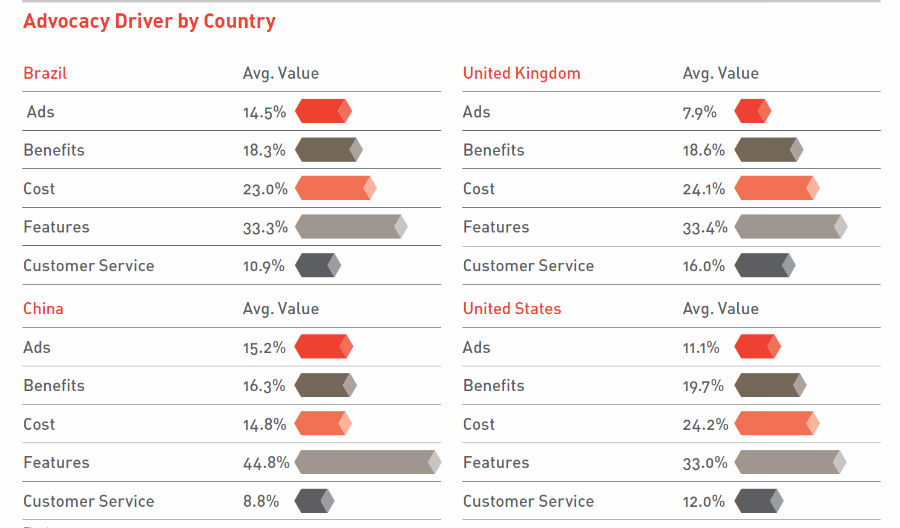Organic advocacy is far more valuable than anything your brand can buy. User-generated affection has a powerful and effective reach that is more influential than any great ad campaign or well-trained employee. By developing a strong brand advocacy program, your company can spend less on advertising and create more effective engagement through user-generated content.
A recent study from Social@Ogilvy uncovered that brand advocacy primarily stems from product features more than ads, benefits, cost and customer service. This shows that it is important to showcase your best features, stay aware of customer expectations, and monitor your brand's digital presence to create and preserve brand advocacy that drives sales.
Related Article: Social Media for Small Business: It's Not All "Likes"

Identify Drivers
As seen in the chart above, customers attach themselves to your brand through a variety of drivers. To be effective, it is important to identify the specific reasons customers love your particular brand and then amplify them. Frequently, advocacy stems from offering a quality product or service, but the additional benefits offered through customer service and personalized engagement can help set you apart from the competition.
To establish your specific drivers, don't make assumptions about your brand and what customers expect; instead, listen to what customers are saying about your brand and decipher your focus areas from both positive and negative dialogue. Listen and apply feedback to improve the social reach of your brand.
Focus On Relationships
Developing strong, personalized relationships with customers is the key to earning advocacy and driving sales. According to Deloitte, customers that are referred by other customers have a 37% higher retention rate.
In today's digital age, users personally identify with brands they love and want to feel as though they are a part of those brands' narratives, so validate those feelings by offering value and building trust with users through communication. The relationship-building process between brand and customer is a two-way street that requires attention and thought to establish long-term and frequent engagement. Be transparent with your users, but don't try to push sales. If you can give more and ask less from your customers they will want to engage on their own.
Building these relationships can take time and resources. Develop a marketing strategy to stay engaged. Ensure you have the necessary resources available to develop and maintain relationships through community monitoring and constant engagement.
Related Article:Are You Creating a Bad Business Reputation?
Inspire and Surprise
Go above and beyond with customer service to create moments worth talking about. By surprising your customers with exceptional service and unexpected benefits, they are more likely to return and share their experience with friends. Try reaching out to user to invite them to a VIP experience. Select influential users or create brand advocates out of unsuspecting fans.
One great way to get started is to monitor your Yelp reviews or social media engagement to find users who love your brand. Reach out to them and offer them something special or even something as small as a personalized thank you for supporting your business. This recognition can go a long way for the connection users feel to your brand. Remember that brand advocacy can be contagious and quality relationships can drive sales.
Enable and Encourage
Help your advocates be heard. Include sharing options in your content to make it easier for users to share their affection towards your brand within their networks. When users talk about your brand, echo their praises in your social networks to increase reach and further develop their advocacy. Reward your biggest fans with special call outs, exclusive offers, and incentives.
Measure Success
To understand the reach of your advocacy campaigns, take a close look at the who, what, where, when, and why of your shared content:
- Who is producing content about your brand?
- What are they saying to their followers?
- Where are they sharing the most content?
- When are users most engaged?
- Why are they sharing your content and talking about your brand?
By monitoring website analytics and conversion rates, marketers can gain insights into what campaigns create the best ROI. Leverage this knowledge to develop your advocacy strategy and create valuable long-term relationships that drive sales.
Conclusion
Creating a brand advocacy strategy really boils down to developing and maintaining relationships. By cultivating two-way communication, your users will feel more integrated into what makes your brand unique and more likely to encourage their friends to take part too. Reward your biggest advocates to create a snowball effect that produces more quality leads.